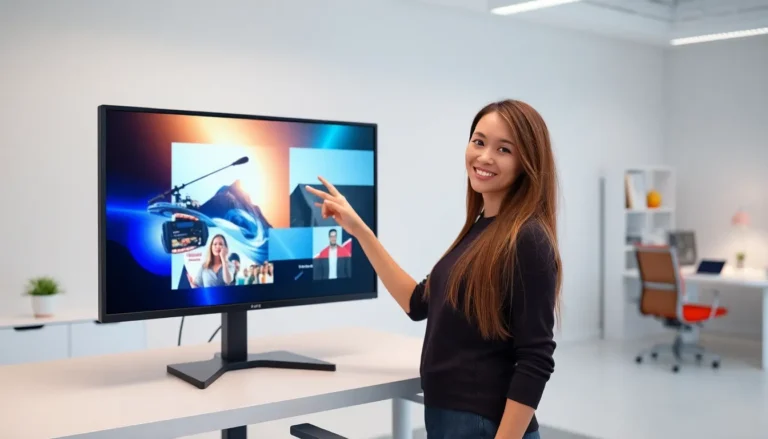Table of Contents
ToggleIn a world where technology reigns supreme, understanding the basics can feel like navigating a maze. Ever found yourself staring at a computer and wondering what makes it tick? Spoiler alert: it’s not magic! It’s all about hardware, the unsung hero of your digital experience.
Understanding Computer Hardware
Grasping the concept of computer hardware is essential for anyone using technology. Understanding the components aids in recognizing how computers operate and impacts overall user experience.
Definition of Computer Hardware
Computer hardware refers to the physical components that make up a computer system. Examples include central processing units (CPUs), motherboards, memory modules, and storage drives. These tangible parts work together to support the functionality of software applications. Different devices also qualify as hardware, such as printers and keyboards, which interact with the main system. Hardware provides the foundation necessary for a computer to process data and perform tasks.
Importance of Computer Hardware
Computer hardware plays a crucial role in overall system performance. Speed, efficiency, and capabilities often depend on the quality of the hardware used. Upgrading components can directly enhance processing power and storage capacity. Device longevity also links to hardware quality; reliable components yield extended use. For businesses, investing in robust hardware translates to improved productivity and reduced operational disruptions. Understanding hardware helps in making informed decisions about purchases and upgrades.
Examples of Computer Hardware
Understanding the various components of computer hardware is crucial for grasping how computers operate. Each group of devices serves a distinct function, contributing to the overall performance.
Input Devices
Input devices allow users to send data into a computer. Key examples include keyboards, which enable text entry, and mice, which facilitate navigation. Scanners capture physical documents and convert them into digital format. Game controllers enhance user interaction in gaming. Touchscreens provide an intuitive way to interact with the device by directly touching the interface.
Output Devices
Output devices present data from the computer to the user. Monitors display visual information, while printers produce physical copies of digital documents. Speakers convert audio output into sound, enhancing multimedia experiences. Projectors enable large-scale displays for presentations and events. Headphones provide personalized sound experiences for individual users.
Storage Devices
Storage devices retain digital information for long-term access. Hard disk drives (HDDs) offer significant storage capacity at a low cost. Solid-state drives (SSDs) provide faster performance due to no moving parts. USB flash drives allow for portable storage, making it easy to transfer files. Optical discs, such as CDs and DVDs, store data using laser technology, catering to various multimedia needs.
Internal Components
Internal components form the backbone of computer performance. The central processing unit (CPU) executes instructions and processes data. Random Access Memory (RAM) temporarily stores data, allowing quick access for currently running applications. Motherboards connect all components and facilitate communication between them. Graphics processing units (GPUs) handle complex visual rendering, essential for gaming and graphics design. Power supply units provide necessary energy for all internal components to function effectively.
Distinguishing Hardware from Software
Understanding the distinction between hardware and software is vital for comprehending computer functionality. Hardware consists of tangible components, while software includes the programs that run on this hardware.
Key Differences
Hardware represents the physical parts of a computer, like CPUs and graphics cards. Software provides instructions that hardware follows to perform tasks. While hardware is the machinery that executes operations, software offers the commands for those operations. Longevity and physical wear apply to hardware, but software typically updates and evolves over time. Each plays a unique role in system performance; one cannot function without the other, creating a partnership crucial for efficient computing.
Examples of Software
Software encompasses various applications and systems. Operating systems, like Windows and macOS, facilitate interaction between the user and hardware. Productivity tools, such as Microsoft Office and Google Docs, help users complete tasks efficiently. Graphic design software, like Adobe Photoshop, provides tools for creative work. Games also fall under the software category, offering entertainment through programmed experiences. Multimedia applications allow for music and video playback, enhancing user engagement with technology.
Common Misconceptions About Computer Hardware
Many people confuse computer hardware with software, believing both are the same. Hardware consists of physical components, while software includes the programs that run on these components. A common misconception is that hardware does not require maintenance, yet all components need care to function optimally.
Some assume that all computer parts are interchangeable. Compatibility is critical; certain components, like the CPU and motherboard, must align with specific standards for proper operation. Users often think that upgrading hardware automatically enhances performance, overlooking that functionality also depends on software efficiency.
Another myth involves assuming that only computers need hardware. In reality, devices like smartphones, tablets, and gaming consoles also rely on hardware components. People frequently underestimate the impact of hardware quality on system longevity, as inferior components can lead to faster failures and increased operational costs.
Misunderstandings also arise regarding the necessity of advanced hardware. Not everyone requires high-end graphics cards or large memory capacities for everyday tasks. Different users have varied needs; someone focusing on web browsing has different requirements than a gamer or graphic designer.
Lastly, some believe all hardware is physically visible. Internal components like CPUs and RAM are often hidden but play a vital role in the system’s performance. Clarity about these misconceptions fosters a better understanding of how computers operate and strengthens decision-making regarding hardware purchases and upgrades.
Understanding computer hardware is vital for anyone navigating today’s technology landscape. It’s not just about recognizing components but also appreciating their roles in overall system performance. By grasping the distinctions between various hardware types and their functions, users can make informed decisions about upgrades and purchases.
Investing in quality hardware can significantly enhance productivity and extend device longevity. As technology continues to evolve, staying informed about hardware developments will empower users to optimize their computing experience. Embracing this knowledge ensures they’re better equipped to tackle the demands of modern technology.





